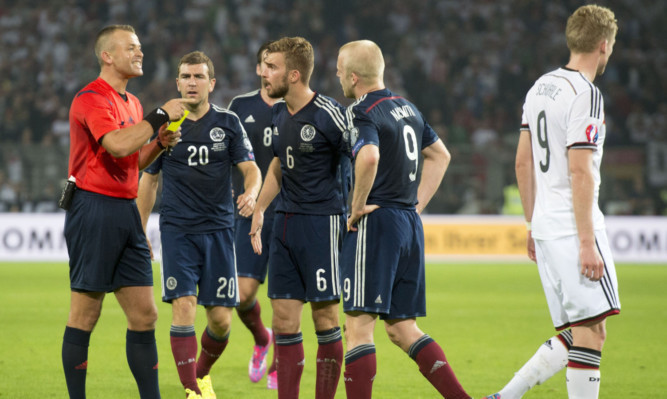
In a week where we saw Scotland robbed of a result in Germany by poor officiating, it was frustrating to hear Sepp Blatter pushing the case for referrals of refereeing decisions.
Frustrating not because it is the wrong thing to do it isn’t but because this was an idea I proposed way back in 2009! Then Chief Executive of the SFA, I raised the issue with the Football Committees of both UEFA and FIFA.
It started when UEFA asked for suggestions to put to the management committee. I said in highly-televised games could there be an opportunity for coaches to challenge decisions which have been shown on television to clearly be wrong.
Ones that everyone sitting at home had seen to be wrong. I said each team could get two challenges and that it would be largely like tennis.
Franz Beckenbauer stood up and said football and tennis are two very different games. But I was convinced it could work and argued my case. It is wrong to say it would detract from the game as a spectacle.
Look at cricket. You get a great deal of excitement as people wait for the decision to be announced. It adds a bit of theatre. And in situations like penalty claims you get a natural break in the game so the flow is broken anyway.
I also pitched it to FIFA. There, the Chief Executive, Jerome Valke, said such a system would detract from the referee’s decisions.
I referred him to the infamous Thierry Henry handball ‘goal’ against the Republic of Ireland through which France qualified for the 2010 World Cup in South Africa.
Millions were furious because they felt rightly as it turned out that Ireland had been cheated out of the competition.
Valke argued the system might not have worked anyway as by then the Irish might have already used up their two challenges. But had that been the case it would have been their own fault because it would mean they had used up their challenges frivolously.
That is because if your challenge is successful, it rolls on just as it does in cricket.
Scotland could definitely have benefited from that system in the game at Dortmund. There were, I believe, several incidents on Sunday that would have been overturned if challenged.
Both Steven Naismith and Shaun Maloney were manhandled in separate incidents that could each have led to red cards.
Charlie Mulgrew, who was sent off for a second bookable offence, was himself fouled in the build up to Germany’s second goal. And Ikechi Anya, our scorer, was brought back by the referee when he should have been free to run in on goal.
These things make a huge difference. Of course there can’t be challenges for every part of the game. It would be stupid, for example, to be able to appeal a throw-in. But for key incidents goals, sendings off etc it could be invaluable.
As it is, I think there is plenty of cause to be optimistic about Scotland’s chances of qualifying for Euro 2016. We certainly deserved a draw against Germany, the current world champions, and could have had a win.
What we did get, on a night results didn’t go our way, was a great showing. A real team performance full of commitment and effort which bodes well for our upcoming ties against Georgia, Poland the Republic of Ireland.
Repeat that display and we will take points, I am sure of it.

Enjoy the convenience of having The Sunday Post delivered as a digital ePaper straight to your smartphone, tablet or computer.
Subscribe for only £5.49 a month and enjoy all the benefits of the printed paper as a digital replica.
Subscribe